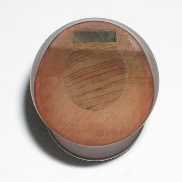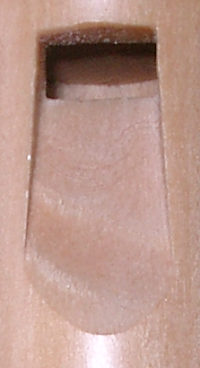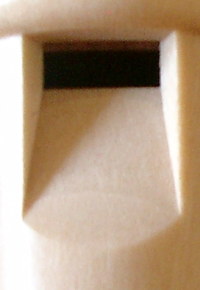Saunders RecordersProprietor John Everingham FTCLRecorder Qualities.I have deliberately chosen an ambiguous title for this page. I hope to cover both the attributes and prices of recorders. My lists have 'smiley' markers If you do not already play the recorder the question of which which size to get or start on looms very large. There is no easy answer. You will have to make your own mind up but I have listed the important factors to consider below. Most beginners start with the descant (soprano), the usual first recorder, for one or more of these reasons:-
Those who play the treble (alto) recorder usually start playing it for these reasons:-
The other recorders are big, costly and generally not suitable for beginners. If you want to play the sort of music that works better on the descant recorder a tenor is a possibility but there are drawbacks. The tenor is not easy to handle, even for an experienced player. If you are of advancing years, are small or have joint problems (particularly all three factors combined) I strongly advise against attempting the tenor recorder. It is almost inevitable that you will have trouble covering the holes and suffer discomfort, if not real pain, in your hands. Solutions like keys are not so effective as you might expect. I have posted advanced comments on tenor recorders here. Price is a fairly easy issue, to a large extent you get what you pay for. Most of the cheapest recorders are rubbish, toys at best. Beware of most instruments that to not trace their ancestry back to a musical instrument manufacturer. White and pretty coloured recorders are unlikely to be very worthwhile as musical instruments, but there can be surprises, I have played a "My Little Pony" descant in puke making pastel colours that was a usable musical instrument! Most, but not all, wooden recorders are better than plastic recorders, though I think that the dividing line of quality between the more expensive plastic recorders and the cheaper wooden ones is indistinct. The notion that any particular material makes a recorder that is 'easier to play' (whatever that means!) than any other, is false. Wooden recorders are sometimes credited with all manner of superior qualities. Do not be taken in. There are many very poor (and fairly high priced) wooden recorders about. A plastic recorder is generally the best choice for an absolute beginner. Once a fair degree of proficiency has been acquired, an improving player should be able to judge what a more expensive wooden recorder offers and make a sensible informed choice. I do not attach much importance to whether a baroque ('normal') recorder has a separate foot joint. Cheaper wooden descants never do... in order to keep the price down. Many very high quality descants are made without one. Indeed, my favourite descant, the one I use for solo performance, is made this way. It is fairly usual for 'early' model trebles and tenors not to have a separate foot and this can be a problem.The position of the lowest hole is sometimes unsuitable for a particular player. I am unconvinced about the value of keys on trebles. If you have a normal hand you are likely to find that they make problems worse, particularly if you are looking for help with bottom F#. Turning a moveable foot joint so that the holes are 'nearer' tends to put them at a awkward angle. The answer is to revise your whole hand position, move away from the concept of covering the holes with the tips of your fingers and straighten your fingers, so that the holes are covered with the fleshy part nearer the joint. The most difficult questions I have to answer at the shop relate to the performance of expensive recorders compared with cheap recorders. Expensive recorders are bought for all sorts of reasons, some of them not valid. There are times when the customer is not entirely happy with the purchase (often for someone else) and returns for advice or reassurance. Often I have to call upon my diplomatic skills to avoid causing an upset. There are those to whom a recorder is more of an artefact than a musical instrument. An expensive one is bought in order to be flaunted, like jewellery, or a clothing, to gain admittance to a club or a higher level of society. As a shop keeper, I have to provide what the customer wants, but it is difficult to cope with complaints that an expensive recorder "won't play" or "doesn't sound any better that a cheap one". The trouble lies in the fact that a musical instrument is a tool, and the old comment about a bad workman and his tools can be very apt. (While on the subject of tools, a recorder maker spends about as much time sharpening his tools as he does shaping the wood.) Part of the problem is that cheap recorders can be tremendous value for money. Be wary of those who criticise your instrument rather than your performance, particularly if you are young. It is not helpful to be told that you will "play better", or "succeed in your exam" if you buy a more expensive instrument. That is a form of blackmail. An experienced player will know whether your performance is limited by your recorder or not and be more understanding and constructive. Unfortunately, recorder players are often at the mercy of other woodwind players who have slight recorder knowledge and give bad advice. It is all too easy to appear wise and tell you to buy wood when it is easy to see (if not hear) that you are playing on plastic. If you are an older artist you should be able to make your own decisions. You will see an account of my second encounter with a "master" on my "new fingerings?" page. My first was some thirty years earlier when I moved to Bristol and had the choice of joining either a recorder ensemble or youth orchestra. I auditioned for both. I remember nothing of the recorder audition except that my (handmade) Dolmetsch instruments were disparagingly referred to as "soloist's instruments" and that I would have to play Kung if I wanted to join the ensemble. (I was not impressed!) At the orchestra I was invited to join them for an evening and was subsequently enrolled there and then. I could play and that was all that mattered. It turned out to be a life changing decision. If you only need a recorder to play tunes, or to take part in group playing, there is no absolute need to acquire an expensive instrument. Its role may be compared to that of a donkey, docile, long suffering and able to take goods on real journeys, or children under supervision along the beach. However, for greater speed, style and excitement, a pony or horse is more appropriate. But there are penalties, like increased cost and the need to learn to ride properly. If you want to compete at the Olympics, both rider and horse have to train together for years to establish the rapport and trust that enables them to perform as one. It is much the same with recorders. The cheap ones can be excellent donkeys. Do not buy an expensive instrument in the expectation that it will automatically turn you into a good performer. The answer to the problem of choice lies in knowledge. If you are not fortunate enough to have a teacher, or have a teacher whose experience is only with "donkeys" you must do all you can to learn and understand where the recorder playing road leads and decide if that is the way you really want to go. The way to do this has never been easier (but it is still not a push over). Listen to broadcasts and recordings of recorder music and ensembles that include recorders. Get a real feeling for the instrument. Beg, buy or borrow printed music for the great works and learn to play them (off by heart even). You don't have to play them fast. Learn the notes and get a feel for the music. Learn some scales and arpeggios too! Copy the style of a performer who appeals to you. Build yourself a foundation and when you are secure in what you are doing branch out for yourself. Find an experienced keyboard player and form a partnership. One thing will lead to another. At some stage you will probably want more from your recorder than it will give. When you have reached this point you should be able to play different recorders, understand the finer points of their tone and response and have got past the "it won't play top whatever" stage. I cringe when customers talk about "a nice mellow recorder". With some old models the tone is soft and as they are forgiving of undeveloped technique it is very easy to play all the notes. These are not actually "good" instruments in the strict sense of the word, though they may be thought so by their owners. Mellowness has no more to do with recorders than processed has to do with cheese. Acquire some knowledge and understanding so that you can make a proper valued judgement. I hear people "test" recorders by playing a different (fast) piece on each instrument, using wrong fingerings repeatedly, and never playing anything other than the scale of the home key and never pausing to listen to themselves. Their choice tends to be the instrument on which (by pure fluke) they managed to play a tune without making a mistake! They frequently ask me to tell them the fingerings for the top notes, and then they are surprised when they cannot produce them. (Unfortunately, top F# is an unsatisfactory or even unplayable note on most recorders.) I have even heard customers blow two recorders at the same time (goodness knows why, I don't, and neither do they, I've asked them). None of these things help you make a choice. I have occasional visits from one very expert player who is interested in any new model. Before he plays any snatch of music he plays long notes at various dynamic levels, exploring the sound. Both he and I learn from the experience. So, you should judge the sound. Do you prefer it "full", or "reedy"? Do the top notes sound the way you like? What happens when you blow it hard, does the note fly away and and go unacceptably sharp? Do any of the notes "burble" unacceptably? Are you prepared to adjust any of your standard fingerings to accommodate a note or two with wayward tuning? Consider these things before you look at the price or colour. Bear in mind also, that if you are a competent player, a good instrument will, to some extent, grow to like you. I hesitate to mention this, it could be used as a catch all answer to criticism and I do not use it as a sales line, but, in general, it is true. The player and instrument come to work together. This is particularly so for wooden instruments (speak to a violinist about it) and also happens with metal. I have found in the past, as a flute player, that if I did not like to way a player played, I would not like the feel of their instrument, even if it was nominally the same as my own. Having bought such a flute, am happy to report that I believe that I have retrained it, though it took me a while. You have a right to expect a cheap (plastic) recorder to play all the notes well enough in tune to be musical and pleasant with a properly tuned piano and in recorder groups. The better ones will have a well focussed sound and will be less critical of breath pressure. (Poor quality recorders, if they play in tune at all, do so only at very low breath pressure with its attendant quiet sound.) Low priced wooden recorders should sound at least as good as the better plastic (though perhaps not as good as the very best plastic). If you discard the cheapest, which are generally badly tuned, the sound may be a bit weak or a bit hard depending on the make. I do not stock recorders in the "cheapest" category. (For detailed comments on different woods refer back to here.) Recorders with plastic heads are an interesting compromise between price and performance. They are robust and can be a good choice for children. Better wooden recorders are well tuned and have a focused sound with character. The balance of tone depends mainly on the maker, but also on the wood. Some design features have attracted more attention than others. In particular there is much store set by narrow and arched wind ways. Most modern production has these features. Many older C20 instruments do not. I do not believe that it is possible to rank a recorder in terms of these features alone. There are many other visible subtle aspects of the design that are at least as important and even more that are not visible, and more important. The best machine made recorders are serious musical instruments, fit for serious players, and are made of better timber, generally referred to as "hardwood", which is longer lasting. Some are hand finished. They are much more stable in pitch (with breath pressure and loudness) and have what most agree is better "tone" than plastic and cheaper softwood instruments of the same general design. The very best recorders are individually hand crafted from selected high quality, often exotic, woods. They are made with subtle features not possible to produce with machinery and their playing properties are adjusted individually by a player. They are freely available, but sometimes subject to long order times on account of demand. Often you deal directly with the person who actually makes them. Whether these recorders sound better in your hands than a cheaper mass produced instrument is up to you, they certainly should. If you were to give me a Stradivarius violin and a bow I would only be able to produce sounds like my cat when I stand on its tail and my efforts on a cheap mass produced violin might well be less hard on the ear. But... I don't profess to be any sort of violinist. What to Look For.The following pointers may serve as a guide. Mid-price instruments of very low quality in nice packaging are appearing here in the UK. They are also being heavily promoted on the internet. Beware! They do not live up to what it says on the box. I am not going to name names, though I do know a few. Even the uninitiated should be able to spot some of these undesirable features.
Below is a style of labium or window that I regard as producing the best quality of sound. (These images are to the same scale.)
I had some fun producing a really bad recorder sound file. Here is a link to it. I demonstrate the difference between good and bad descant recorders. You can find a bit more about the value of recorders by clicking here. My 'Smiley' Choices.






To qualify for a smiley a recorder has to satisfy me that it comes up to a good standard in the following aspects of playability. I have only used them for lower priced instruments and, inevitably, these recorders do not meet the highest standards of the more costly models. They are, however, worthy recorders and, within their limitations, will satisfy the needs of a player who appreciates good musical qualities.The smiley marks, when considered in price order, show my choice in order of quality and value for money. If you arrived here from a link please have a look at the rest of the page above.
Quick Guide to Price Bands and FeaturesI do not stock bad recorders so even using a blindfold and a pin will select a good instrument from my list. To avoid getting bogged down in the minutiae of detail this may help some who have preferences that are difficult to resolve.
|


